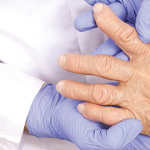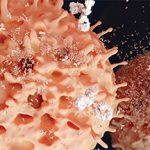
MADRID—Prevention is the ultimate goal with any disease, including rheumatoid arthritis (RA), and researchers here at the European League Against Rheumatism (EULAR) 2013 Annual European Congress of Rheumatology, held June 12–15, presented cutting-edge work aimed at that end, with projects from identifying who is most at risk to potential ways to intervene and prevent onset.
Prevention as a bona fide topic in itself represents progress, although Dirkjan van Schaardenburg, MD, PhD—who chaired the session and is professor of rheumatology at Jan van Breemen Research Institute in Amsterdam—said answering these questions will require a lot more work. “There are many more answers to be found for the questions,” he said.
Which Antibodies Indicate Risk?
Solbritt Rantapaa Dahlqvist, MD, PhD, professor of rheumatology at the University of Umeå in Sweden, presented work that delves deeper into the relationship between antibodies against citrullinated proteins and peptides (ACPA) and the development of RA.
She and her team mined data from the Medical Biobank of Northern Sweden, a collection of more than 210,000 blood samples from 131,000 people in the general population, who give blood samples in exchange for a medical check-up.
Researchers analyzed the samples from those with nonsymptomatic pre-RA, those with RA, and controls to assess the presence of antibodies against an array of citrullinated peptides.
They found that the fluorescence intensity of antibodies against fibrinogen (Fib) ß36-52, Fibß74, CEP-1, citC1III, and filaggrin were significantly increased in those with predisease compared to controls. Antibodies against Fibß36-52, CEP-1, and filaggrin increased gradually, eventually reaching the highest levels of all antibodies before the onset of symptoms.
The earliest detectable antibodies—Fib∝591 and vimentin 60–75—increased only slightly before the onset of symptoms, but more so after disease onset.
The risk for development of RA was highest for filaggrin (odds ratio [OR] 11.64), Fibß74 (OR 10.68), and CEP-1 (OR 6.27), and those risks remained high after adjustment for the presence of HLA-shared epitope and smoking, suggesting an independent relationship for RA development, Dr. Dahlqvist said.
Researchers also looked at the risk involved with combinations of antibodies, HLA-shared epitope, and smoking and found that the combinations including CEP-1 or Fibß36-52 came with an OR of 38.8 for developing RA, compared to having either one individually and being HLA-shared epitope negative and nonsmoker.
Dr. Dahlqvist and her team have also evaluated the role of salt intake. The work is unpublished so far, but she said the findings have been interesting.


